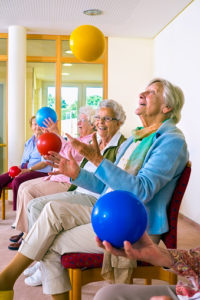According to the American College of Sports medicine, by the year 2030 there will be over 70 million people age 65 plus. It is important for this age group, as well as every age group, to stay healthy and strong by participating in regular exercise. There are many exercise myths that often prevent seniors from beginning or continuing an exercise program. Below the facts and myths of senior exercise are sorted out.
Myth: It is too late to start exercising.
Fact: Exercise is beneficial for all ages, even those beginning exercise later in life. Muscle mass naturally decreases after age 40; however, it is possible to build muscle at any age. Strong muscles make daily tasks easier, and provide balance and stability to prevent falls.
Myth: I will injure myself during exercise.
Fact: Although injuries can happen during exercise in any age group, if your loved one attends a fitness class designed specifically for seniors, with professional instruction, he or she will minimize this risk. Low impact, light resistance classes are best for seniors just beginning a fitness program. Classes can often be found at a local senior center or council on aging. Also, most senior living communities, such as assisted living, continuing care retirement and even Alzheimer’s communities, have specialized fitness programs for their residents.
Myth: I am not flexible enough to exercise.
Fact: Perhaps you have noticed that you or your loved one has decreased range of motion. This is not an obstacle to exercising. Exercise, especially classes that specifically incorporate stretching, improves range of motion and function in seniors. This can relieve muscle and joint pain associated with stiffness and lack of circulation.
Myth: I have osteoporosis so I cannot exercise.
Fact: Osteoporosis should not prevent exercise at any age. Exercise actually strengthens the bones by stimulating bone growth, therefore combating osteoporosis. Risk of breaks or fractures is lowered in senior populations that exercise. It also improves function in seniors with osteoarthritis.

 Kim Vareika
Kim Vareika
